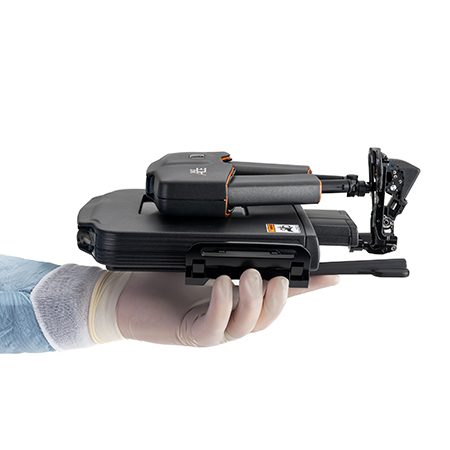XACT ACE Robotics System Receives Expanded FDA Clearance For Ablation Procedures
Executive Summary
Medtech Insight spoke with XACT Robotics’ executive chairman Harel Gadot about plans for the FDA-cleared ACE robotic system and its market opportunities.
After COVID-related setbacks, placements of XACT Robotics Ltd.'s ACE hands-free robotic-assisted device for use in percutaneous interventional procedures are gaining traction in the US.
Harel Gadot, XACT’s founder and executive chairman, told Medtech Insight that the company expects to sell six ACE Robotic Systems by the end of June, adding to the four systems sold since it was first cleared by the US Food and Drug Administration in 2019. The FDA-cleared indication is for computed tomography-guided percutaneous interventional procedures.
On 18 May, XACT announced it received an expanded FDA clearance for the ACE robotic system for ablation probe insertion and steering, which, according to XACT, has the potential to save health systems time with fast and accurate probe placement.
Gadot puts the total addressable market for the system at 20 million interventional percutaneous procedures performed worldwide, including ablation, biopsies, drug delivery, drainage and pain management – all procedures which are typically done manually.
“There are many unmet needs in this market,” he said. “It’s incredible to see such a big market where nothing has been developed to solve this problem over the last few years.”
“There are many unmet needs in this market. It’s incredible to see such a big market where nothing has been developed to solve this problem over the last few years.” – Harel Gadot
Gadot said the ACE robotic system addresses limitations of manual methods and other image-guided percutaneous intervention systems by improving “accuracy, consistency and efficiency” of these types of procedures, as the name ACE implies.
The ACE robotic system aims to improve patient outcomes and reduce readmissions by avoiding having to reposition the patient and requiring multiple instrument insertions to reach a specific target, which Gadot said is a problem with these types of procedures.
The ACE robot is a handheld device about the size of an iPad. Its software allows interventional radiologists to assess real-time patient CT images and plan the procedure, including selecting the target, entry and checkpoints, and monitoring instrument advancement.
The robotic system is placed on the patient’s body after confirmation of the procedure’s trajectory – the robot does its own registration – and then inserts the various instruments with non-linear steering and maneuvers around obstacles toward a target – without the physician touching the instrument.
Gadot noted that the system uses “off-the-shelf” instruments, including ablation probes and coaxial needles from companies such as Medtronic plc, Boston Scientific Corporation and Johnson & Johnson (Pty) Ltd.
The physician is responsible for all the clinical decisions – planning and approving the procedure and then monitoring it while the robot performs the insertion and non-linear steering, Gadot explained.
The robotic system also comes with an optional remote-enabled feature, the ACE XTEND, which allows an operator to perform the procedure from another room, protecting the user from radiation. The remote has been conditionally approved by the FDA for emergency use during the public health crisis. The company anticipates full FDA clearance sometime this year.
The ACE robotic system’s unique use of advanced algorithms gives it non-linear steering capabilities which allows access to hard-to-reach anatomical targets. Gadot said the system has shown in more than 320 cases – both commercially and pre-clinical – an accuracy of less than 1.7 mm average tip to target. This allows physicians to diagnose and treat patients earlier rather than sending the patient home for “watchful waiting,” which is anxiety-provoking for patients.
The system also addresses the challenge of tissue moving during the procedure, where patients are often awake, as well as irregular breathing, which adds to the complexity of using instruments, he noted.
“When you start putting an instrument into the body of the patient, everything is moving,” he said. In many procedures, physicians need to reinsert the instrument to reach a desired target, or reposition the patient to try to find a better access point, which lengthens procedure times. Procedure times can range from 20 minutes to 90 minutes, he said. According to Gadot, the ACE system can reach a site in less than 8.5 minutes with a single insertion to target.
He expects the ACE robotic system also will “democratize percutaneous procedures” by reducing the clinical variability of physicians. Because it manages the technical aspects of instrument insertion and steering, the robotic system can be used by other health professionals, such as physician assistants and nurse practitioners, to perform certain types of procedures.
Gadot declined to give pricing. The system is currently used by physicians at the interventional radiology team at Sarasota Interventional Radiology in Sarasota, FL, Beth Israel Lahey Health System in Boston, MA and at Memorial Sloan Kettering Cancer Center in New York City. The company said the system has been used in more than 200 cases to date. (Also see "Digital Health Roundup: AI Trends In Medtech; Exec Chats; FDA’s Digital Health Guru Steps Down" - Medtech Insight, 16 May, 2022.)
Founded in 2013, privately held XACT Robotics has offices in Hingham, MA, and in Caesarea, Israel. The technology was originally spun out of Moshe Shoham’s medical robotics lab at the Technion-Israel Institute of Technology and further developed at the MEDX Xelerator, an Israeli medical device and digital health incubator. (Also see "Exec Chat: Israel’s Authority On Medical Robotics Lifts Curtain Behind Technion’s Success Stories" - Medtech Insight, 12 May, 2022.)
Shoham told Medtech Insight that the robot is totally non-intuitive for surgeons. He explained that “if the hand that holds the needle is moving right, the tip may go right, or it may go left. It depends on how deep it is inside the body, the tissue, and the factors of the tissue themselves.”
He said that the ACE robotic system is one of few autonomous medical robotic systems, because it is doing the needle insertion and the surgeon does not touch the needle while it is being inserted. (Also see "Expert Panel On Surgical Robotics Expects Autonomous Systems To Democratize Surgery" - Medtech Insight, 21 Aug, 2020.)

